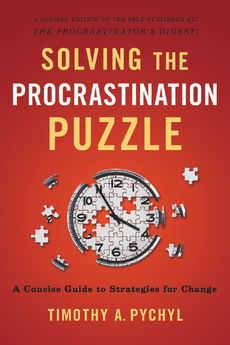Procrastination
Procrastination: Why Mindfulness Is Crucial
Mindful awareness & nonjudgmental acceptance—the path to emotional regulation
Posted March 12, 2014
Why do we procrastinate?

Why do we procrastinate?
The short answer is quite simple, I think. When we face some tasks, we have a negative emotional reaction. These can be transient emotions, even preconscious—meaning that we’re not really aware of these feelings at a conscious level—but we do react to them. We cope by avoiding the task that we perceive is causing these negative emotions or is, at the very least, associated with these negative emotions. This avoidant coping response is procrastination.
Long-time readers of this blog will understand this avoidant coping as the “giving in to feel good” instance. We seek short-term mood repair through task avoidance. This task avoidance is procrastination when we have intended to do a task because, all things considered, it’s in our best interest to do the task at that time, but we needlessly avoid it instead. We’ve become our own worst enemy with a self-defeating delay, but we can learn a better approach.
I have argued here in this blog and in my research (e.g., Sirois & Pychyl, 2013) and book (Solving the Procrastination Puzzle) that procrastination is a self-regulation failure. We fail to regulate ourselves to act as intended. When we face a task to which we have a negative visceral reaction and think “I don’t feel like it” or “I don’t want to” we require self-regulation to proceed despite these feelings.
What I want to emphasize and make clear in this post is that effective self-regulation relies on emotion regulation, and this emotion regulation in turn relies on mindfulness. There is clear evidence that mindfulness is related to less procrastination (including a thesis that is just wrapping up in my research group now). So, we need to begin with the connection between mindfulness and emotion regulation.
Mindfulness and Emotion Regulation
Although I focus on procrastination as an emotion-regulation process, I turn to a recent publication by Rimma Teper, Zindel Segal and Michael Inzlicht (University of Toronto) for an excellent summary of the connection between mindfulness and emotion regulation. This is, I argue, the missing piece, the most essential piece, of what I have come to call the “procrastination puzzle.”
Let’s begin with emotions. Emotions provide information. They are adaptive, for the most part. And, based on these two properties, we have come to understand that emotions have motivational properties. For example, we typically acknowledge that fear motivates a “fight or flight” response. These responses are what evolutionary psychologists consider our “best guesses” about what to do in situations that evoke a fear emotion. Although it’s possible that a task might evoke fear (e.g., fear of failure), there are other more subtle and perhaps transient emotions that define task aversiveness such as boredom or frustration. These emotions motivate us too. They can motivate the avoidance we label as procrastination.
The crux of the issue then is that despite these emotions our successful goal pursuit will depend on task engagement. Despite negative emotions, we need to regulate our behavior towards the task, not away from it. How do we do this?
First, we have to be aware of our emotions. I have noted already that our emotional reaction to a task may not be a “jump up in your face” sort of emotional response that you might have if a poisonous snake just slithered out from under your desk or if you were to hear someone kick in your door just now (I’ll bet both of these examples evoked emotions for some readers, they do for me). In any case, I digress. The thing is we have to be aware of emotions so that this awareness might signal the need for effortful self-regulation.
This is where my colleagues from the University of Toronto fill a gap in the story. Their work, led by Michael Inzlicht, focuses on the link between the executive function resources we require to self-regulate and the mindfulness that we require to call executive function into action. We have to know when to control ourselves.
Their argument in a nutshell is this:
- Mindfulness as a practice cultivates the ability to maintain focus on the present moment. This present-moment awareness provides sensitivity to sensory cues—like that negative emotional “pang” we might feel when facing an aversive task.
- When we are aware of these sensory cues, and, in particular for procrastination, the negative emotions we’re experiencing related to the task, we can instigate control.
Here I would argue that one key feature of executive function is inhibition—and the first step for successful goal pursuit with an aversive task might simply be inhibiting the prepotent avoidance response.
Put more simply, mindful awareness lets me recognize that I’m freaking out about this task or bored stiff by this task and this awareness can signal the need to inhibit my habit of procrastinating. If I can be aware of my emotions, I can exert control and stay put.
Mindfulness is more than awareness, however. Mindfulness also includes the key feature of nonjudgmental acceptance of our emotions (or thoughts). In some fascinating experimental work, Rimma Teper and Michael Inzlicht demonstrated that more experienced meditators—those participants in their study who scored higher in mindfulness—committed fewer errors in their experimental task that measured executive control. They concluded that these mindful participants or any people “…who are able to accept the ‘pang’ of making an error may experience this quick affective state more keenly and may thus be more likely to attend to attend to their errors and prevent them from happening in future trials. These people may be better able to control their behavior because they are more accepting of their errors and associated conflict” (p. 451, emphasis added). Interestingly, they also examined the neuroaffective correlates of this executive control where their research revealed that more experienced meditators showed greater evoked brain potentials generated in the anterior cingulate cortex (an area of the brain associated with executive function).
All this is to say that this research by Michael Inzlicht and his colleagues indicates that when people are accepting of their emotions (an attribute developed through mindfulness), the potential is that they may also may be able to use these transient emotions as signals to do something about them, not just rely on a habitual coping response such as avoidance.
Although research will continue to investigate these links, I think it is intuitively obvious that mindful awareness and acceptance are fundamental first steps in the self-regulation necessary to initiate goal action when procrastination may be the habitual response. If we can cultivate mindful awareness and acceptance, we can better understand when and why we’re motivated to procrastinate, and this in turn can promote more willful attempts to exercise the control necessary to stay the course until the initial emotions pass. I would add that research clearly shows that progress on our goals fuels well-being, so this initial “priming the pump” for action may well be the mechanism by which we move from initially negative to more positive task-related emotions.
Concluding Thoughts
The take home message, and I think the main route for dealing with procrastination as a habitual coping response, is that mindfulness meditation is a powerful tool for each of us. In fact, it may be one of the only entry points available to us to break the cycle of avoidance.
I'll give the final word to Michael Inzlicht and his colleagues,
“…mindfulness promotes executive control by enhancing experience of and attention to transient affects [emotions]—the control alarms—that arise from competing goal tendencies…Early awareness and acceptance of these sensations is advantageous, because it allows people to efficiently recruit regulatory resources” (p. 452).
References
Flett, A. & Pychyl, T.A. (2014). Procrastination, Rumination, and Distress in Students: An Analysis of the Roles of Self-Compassion and Mindfulness. Poster to be presented at the Canadian Psychological Association Annual Conference.
Pychyl, T.A., & Rotblatt, A. (2007). Mindfulness Meditation as an intervention for academic procrastination. Paper presented at the biannual conference, Counseling the Procrastinator in Academic Settings, Catholic University of Peru, Lima, Peru.
Sirois, F. & Pychyl, T.A. (2013). Procrastination and the priority of short-term mood regulation: Consequences for future self. Social and Personality Psychology Compass, 7, 115-127. DOI: 10.1111/spc3.12011
Sirois, F.M., & Tosti, N. (2012). Lost in the moment?: An investigation of procrastination, mindfulness and well-being. Journal of Rational-Emotive and Cognitive-Behavior Therapy. DOI: 10.1007/s10942-012-0149-5
Teper, R., Segal, Z.V., & Inzlicht, M. (2013). Inside the mindful mind: How mindfulness enhances emotion regulation through improvements in executive control. Current Directions in Psychological Science, 22(6), 449-454. DOI: 10.1177/0963721413495869




